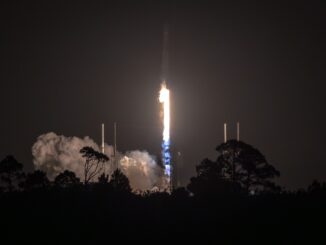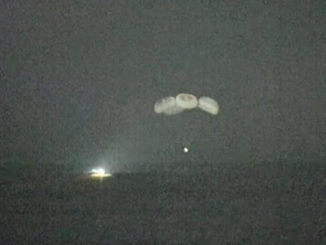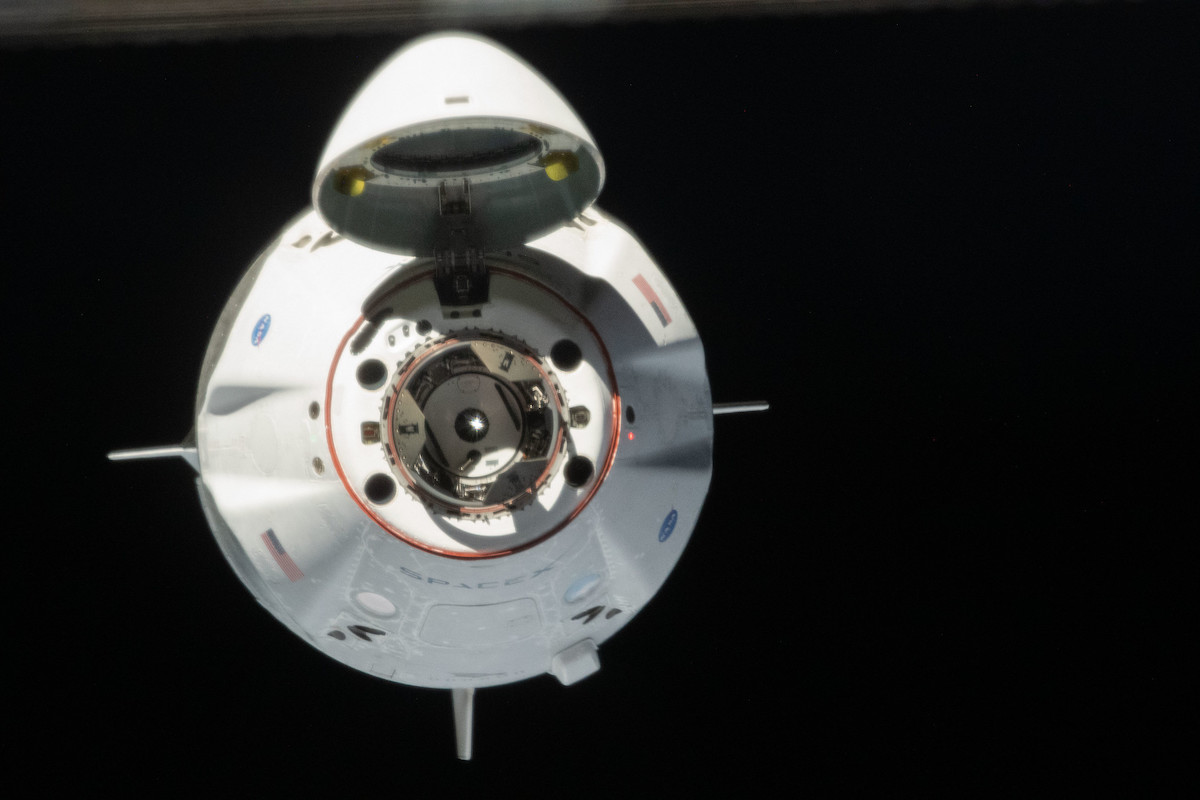
The chief executive of Axiom Space says agreements with NASA, SpaceX, and fare-paying passengers should be finalized in the coming weeks for the launch of the first all-private crew to the International Space Station in October 2021, and former NASA astronaut Michael Lopez-Alegria is set to command the mission.
The roughly 10-day flight will be the first mission into Earth orbit to carry only private astronauts, without crew members from a government space agency. Axiom, a Houston-based company, announced the privately-funded mission in March.
Axiom said then that the mission would include a professional astronaut and three paying passengers flying on a SpaceX Crew Dragon spacecraft to the International Space Station in the second half of 2021.
Mike Suffredini, CEO of Axiom Space, said last week the Axiom and its partners aim to complete contracts in the coming weeks to enable the private mission to launch in October 2021.
“This really is going to be the first commercial flight (with private astronauts), so NASA is working with us to work through all of the unique aspects of that,” Suffredini said in an interview last week with Spaceflight Now. “It’s a short duration flight. So it’ll be relatively easy to implement.
“I say easy, but nothing’s easy in spaceflight,” Suffredini said. “But it’s as simple of a mission as we could be doing, which makes it good for all us. We’ve sorted out almost all the big details. I have to have a contract with NASA, where they affirm our ability to go fly, what the date is, what the requirements they want to levy on us officially are. So we’ve got to get the contract done.
“We’ve got to sign the contracts with our three customers, which we largely already have in place, and sign an update to the SpaceX contract,” Suffredini said. “We want to do that all together. We’re aiming for the end of September, but I’m guessing if we get it done before the end of October closes out, that’ll be a success.”
Suffredini managed the International Space Station program at NASA from 2005 to 2015, when he moved to the private sector. He co-founded Axiom Space with Houston entrepreneur Kam Ghaffarian to organize commercial flights to the International Space Station, and eventually develop a new commercial space station in low Earth orbit.
Officials have identified possible clients for the private space missions, including wealthy adventurers, filmmakers, researchers, and astronauts from nations with nascent space programs.
Suffredini declined to discuss the identities of the private astronauts slated to fly on Axiom’s first commercial mission, designated AX-1. The AX-1 mission will be the first in a series of missions Axiom is scheduling to go to the International Space Station.
NASA Administrator Jim Bridenstine confirmed in June that Axiom is working with Tom Cruise on a project to film a movie on the space station.
“Our customers are private astronauts on these flights, but we don’t fly any private astronauts without a professional astronaut,” Suffredini said. “So the flight will have four seats. We’ll have three customers and an Axiom professional astronaut.”
Shuttle and station veteran to command Axiom’s first private astronaut flight
Veteran NASA astronaut Michael Lopez-Alegria, who retired from the space agency in 2012, will accompany the private passengers on the AX-1 mission, Suffredini said.
Lopez-Alegria, 62, flew on three space shuttle missions in 1995, 2000 and 2002. He launched on a Russian Soyuz spcaecraft in 2006 and commanded the seven-month Expedition 14 mission on the International Space Station. Lopez-Alegria has logged more than 257 days in space on four flights.
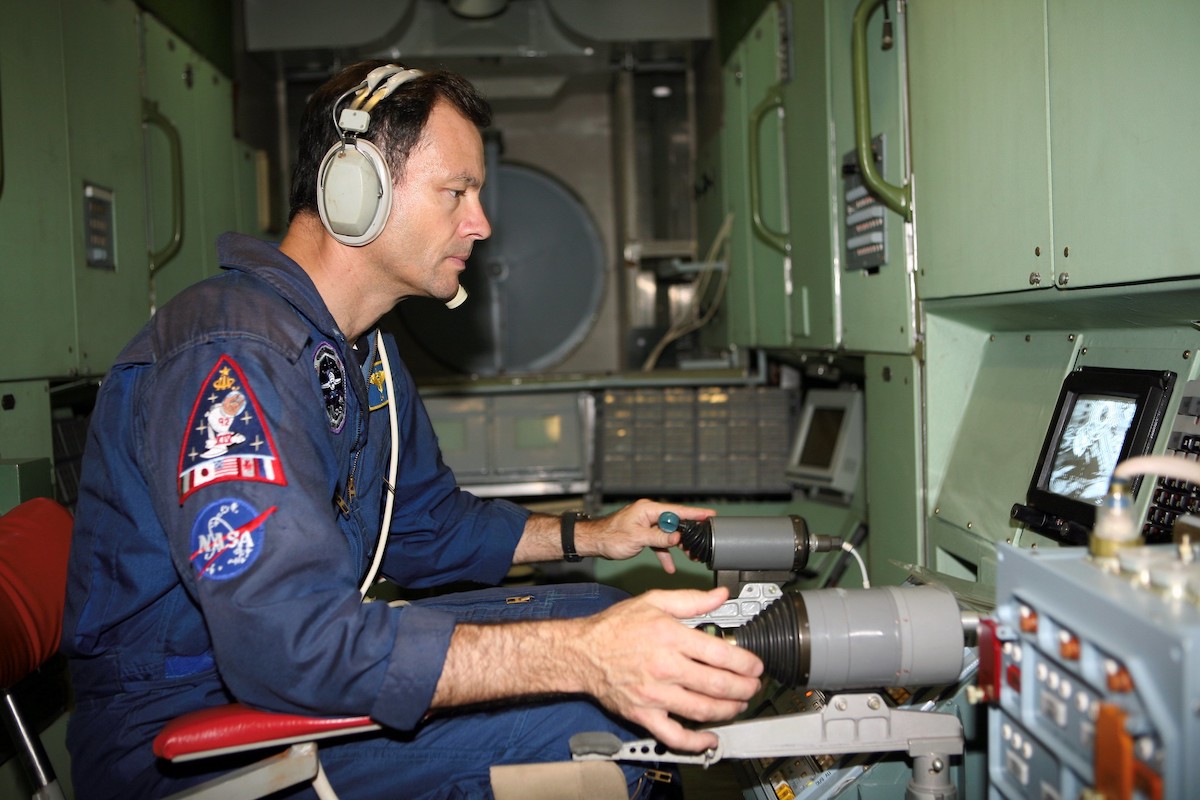
After retiring from the U.S. Navy in 2008 and leaving NASA in 2012, Lopez-Alegria, known as Mike L-A, became president of the Commercial Spaceflight Federation, an industry advocacy group. He’s now a consultant for Axiom, Suffredini said.
“Mike L-A is our commander for our first flight,” Suffredini said.
Lopez-Alegria has helped Axiom recruit prospective customers, and answer their questions about flying in space.
“It’s a very personal element to talk to various individuals who want to go fly,” Suffredini said of Lopez-Alegria’s role with Axiom to date. “It’s a huge experience. It’s a very big expense. It’s really about helping them understand what it’s really like, and helping them get comfortable. The way we do it is really a safe approach … We’re experienced.
“We know what it takes, and know what to expect,” Suffredini said. “That happens over a number of conversations. Mike’s been really instrumental over the past few years helping us be able to do that.”
Once the contracts for the AX-1 mission are in place, Lopez-Alegria will become a full-time Axiom employee, according to Suffredini.
Cruise plans to fly to the space station with director Doug Liman, and a third person will fill the remaining Crew Dragon seat, sources told Spaceflight Now. Officials have not publicly confirmed which Axiom mission Cruise will fly on.
“We’re happy to announce whenever our customers want it,” Suffredini said. “But what we’re finding out is a lot of our customers really aren’t interested in us talking about them too much, so we may not announce the individuals when we announce the flight.”
In some cases, passengers may not want to be publicly identified until closer to their launch date, Suffredini said.
The often-quoted commercial price to fly to the space station and back on a Crew Dragon spacecraft is roughly $50 million. Suffredini confirmed that price is “in the right ballpark.”
The private astronauts on the AX-1 mission will spend about eight days on the International Space Station, and around 10 days total in orbit, including the transit time between launch and docking, and from undocking until splashdown.
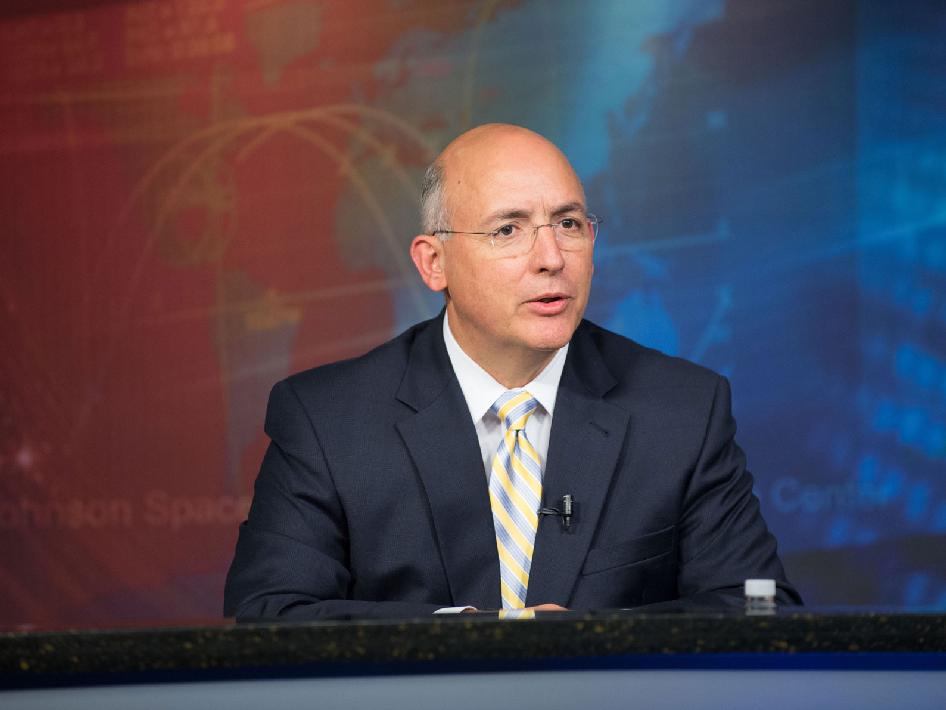
Astronauts flew into space for the first time on the Crew Dragon spacecraft in May. NASA astronauts Doug Hurley and Bob Behnken launched May 30 on top of a SpaceX Falcon 9 rocket, and they reached the space station May 31.
The astronauts completed their 64-day test flight Aug. 2 with a parachute-assisted splashdown in the Gulf of Mexico, verifying the privately-owned Crew Dragon spacecraft can safely ferry people to and from the space station. The demonstration flight marked the first launch of astronauts into orbit from U.S. soil since the retirement of the space shuttle in 2011.
The successful test flight sets the stage for the first operational Crew Dragon flight scheduled for launch Oct. 23 with three NASA crew members and a Japanese astronaut.
NASA’s Crew-1 mission launching in October will span around six months. The Crew-2 mission, another NASA flight with the Crew Dragon capsule, is scheduled for launch next April. NASA has purchased at least six Dragon crew rotation missions through 2024, and the Dragon flights will eventually be supplemented with six operational crew rotation missions using Boeing’s Starliner spacecraft, once it begins flying astronauts.
The AX-1 flight set for liftoff in October with private astronauts will launch amid other regularly-scheduled Dragon missions with long-term space station crews.
While astronauts train more than a year to prepare for six-month expeditions on the space station, the private astronauts Axiom plans to fly for a week-and-a-half will undergo about 15 weeks of training, Suffredini said.
Axiom’s customers will spend about half of that time training in Southern California at SpaceX, which provides the Crew Dragon spacecraft, Falcon 9 launch vehicle, spacesuits, and recovery teams to greet the astronauts after their return to Earth. The other half of the training will primarily occur at the Johnson Space Center in Houston to familiarize the passengers with the space station itself, Suffredini said.
Axiom expects to soon sign final contracts for the AX-1 mission
One of the topics Axiom is negotiating with NASA involves how much insight the space agency will have into the private astronaut mission. While the Axiom missions will be managed by commercial companies, the AX-1 flight will fly with a reusable Crew Dragon spacecraft that will carry NASA astronauts on other missions.
“There’s a certain amount of insight (NASA) would like on our flight, on a commercial flight,” Suffredini said Friday. “So that is one aspect of that process. We’re using a vehicle that is going to be re-flown, and NASA will certify the re-flights because they want to do re-flights.”
Axiom and SpaceX will also have to confirm a schedule with NASA for the AX-1 mission to dock with the space station. The orbiting research complex has a busy schedule of arriving and departing crew and cargo vehicles, and managers also have slot in spacecraft dockings amid spacewalks, experiments, and other critical operations.
NASA also oversees safety of the space station with the program’s international partners.
But for the Axiom missions — with a privately-owned spacecraft and astronauts from the private sector — the companies themselves are ultimately responsible for the safety of the Dragon crew.
“I think NASA is probably going to be more involved in the first few flights,” Suffredini said. “Then the next few, we’ll see how that sorts out. That is one of the things to be sorted out.”
NASA is sorting out the safety approvals it might require for a private astronaut flight to approach the space station.
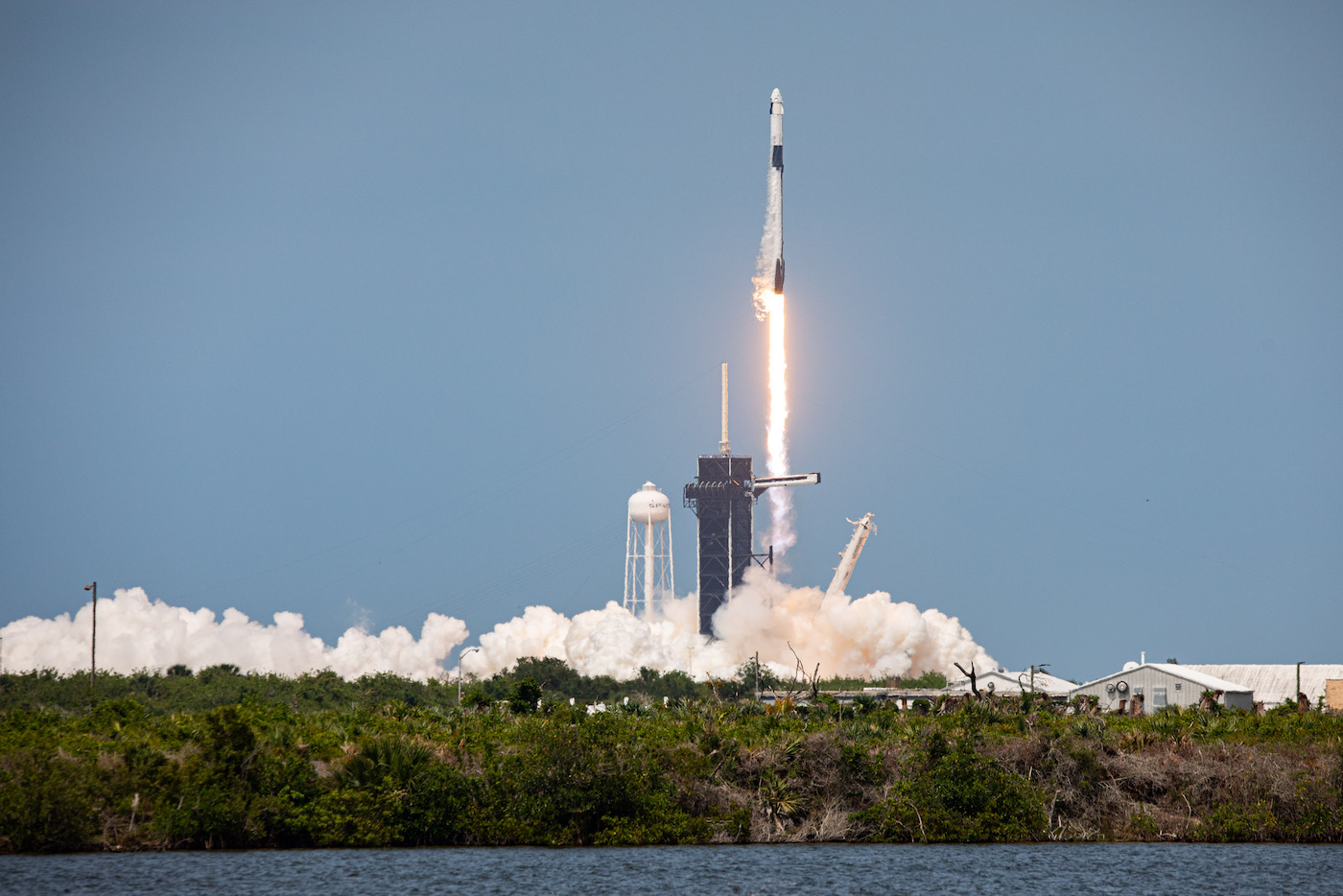
The Federal Aviation Administration licenses commercial launches in the United States. Securing regulatory approval for the launch of a private astronaut mission will follow similar processes used for other launches.
“Because we train at NASA facilities on the ground, there’s some liability there we have to sort through,” Suffredini said. “Then we have liabilities once we enter the sphere around the ISS, and that’s being sorted out.
“The big thing … is that we hold the commercial entities responsible for their aspects of the flight,” Suffredini said. “So SpaceX provides the ascent and re-entry, and that’s their responsibility. And we’re responsible for the crew’s overall training, their medical well-being, everything they do on ISS.”
Once NASA and Axiom come to a final agreement, Axiom will sign a contract with SpaceX specifying a launch schedule and the people flying on the AX-1 mission, Suffredini said. It will be an update to an earlier contract Axiom signed with SpaceX in December 2019 for a private astronaut mission.
“When we signed the SpaceX contract, NASA wasn’t very far along in their planning, so we had to sign it with assumptions,” Suffredini said.
NASA is looking to Axiom and other companies to develop a commercial market for human spaceflight in low Earth orbit after the International Space Station’s retirement, a goal agency leaders say will lower the cost of transportation and operations. In 2019, the space agency announced it would support private astronaut missions of up to 30 days to the space station.
NASA also unveiled a pricing structure for private astronauts who live and work on the space station, breaking out costs for access to the lab’s life support system, toilet, food, water, electricity and other necessities.. The space agency will charge around $35,000 per day for a private astronaut stay on the station.
The private astronaut flight opportunities arranged by Axiom could launch as often as two times per year, the company said.
NASA investment lays foundation for private astronaut missions
Self-funded space fliers to date have flown to the space station on Russian Soyuz spacecraft, joining crews comprised of government cosmonauts and astronauts.
SpaceX’s Crew Dragon spacecraft and Boeing’s Starliner capsule are only U.S. vehicles expected to be available to transport commercial crews to the International Space Station in the coming years. Both human-rated ships were developed in partnership with NASA, which has contracts with SpaceX and Boeing valued at a combined $6.8 billion to build the Crew Dragon and Starliner capsules and fly government astronauts to the space station.
Although NASA supported development of crew capsules, the SpaceX and Boeing vehicles are available for other customers.
Earlier this year, the space tourism company Space Adventures announced an agreement with SpaceX to fly paying passengers on a Crew Dragon spacecraft without going to the space station. Instead, the Crew Dragon will fly on its own in Earth orbit, reaching altitudes hundreds of miles above the space station to provide passengers a more expansive view of Earth.
Space Adventures brokered flights of seven wealthy space tourists on Russian Soyuz capsules between 2001 and 2009.
While Cruise and Liman pursue a Hollywood production in orbit, Russia’s space agency, Roscosmos, announced Tuesday it also plans to help film a Russian movie on the International Space Station in late 2021. Officials will select a protagonist and a backup during an open contest, Roscosmos said.
The Russian film is “aimed to popularize Russia’s space activities, as well as glorify (the) cosmonaut profession,” Roscosmos said.
Lopez-Alegria, the commander of the AX-1 mission, has flown with space tourist before. He launched with Anousheh Ansari, one of the Space Adventures clients, on a Soyuz rocket in 2006, then landed back on Earth with billionaire Charles Simonyi in 2007.
Gwynne Shotwell, SpaceX’s president and chief operating officer, said in August that she is “very comfortable” with a quick transition from the Crew Dragon test flight to the start of commercial service.
“This mission was incredibly smooth, not to say that there weren’t things we want to work on and do better next time, but the capsule worked beautifully,” Shotwell said after the splashdown of the Crew Dragon with Hurley and Behnken. “The operations worked extremely well, so we certainly feel comfortable that we’re on the right path to carry commercial passengers not too long from now.”
Shotwell said SpaceX’s ability to reuse each Crew Dragon spacecraft at least five times will help “change the paradigm of human spaceflight.”
“As a private company, SpaceX is looking at what the demand is,” said NASA Administrator Jim Bridenstine. “At NASA, our goal is to make sure that theres a big demand in the future. I would love see a fleet of Crew Dragons servicing not just the International Space Station, but also commercial space stations, which is why we’re working so hard every day to commercialize our activities in low Earth orbit.”
Hurley, who commanded the Crew Dragon test flight earlier this year, told reporters last month that he expects it will take a “few flights” before engineers can fully wring out the SpaceX capsule’s systems.
“I think it’s going to take a few flights — and I think that’s prudent — before we can consider this vehicle completely tested,” Hurley said. “And then as, we all know, the space business, like a lot of those technically challenging businesses, is not forgiving.”
Hurley said engineers should not let their guard down, and “don’t just assume that because the last flight went perfectly, that the next flight is going to go perfectly. You have to do that rigor, and that analysis, and that attention to detail. And you can’t get complacent. You can never get complacent with a space vehicle.”
Axiom plans regular commercial missions to the space station.
A passenger on an Axiom mission in early 2023 will be the winner of a reality TV show in development by a production company named Space Hero. Suffredini said the mission in early 2023 will likely be AX-4, Axiom’s fourth private astronaut flight to the station.
“We provide to Space Hero what we provide everybody,” Suffredini said. “We’ll train the individual they bring forward to us, and their backup if they have a backup. Then we’ll put them on the flight, and they will be one of our customers on that flight, which is early 2023.”
Axiom has not selected a transportation provider for the mission with the reality show winner. Suffredini said Axiom’s ambition is to eventually choose between SpaceX and Boeing for each private astronaut mission, providing a competitive market for Axiom and other astronaut flight services.
“I’ve been very appreciative of the fact that SpaceX has leaned forward, and has always been willing to work us and make these things happen. so I’m happy to be flying with them,” Suffredini said. “I’ve got no reason not to fly with them in the future. But with Boeing coming along, it’s good for us to know where Boeing is, and when they’re ready to fly commercially, then we’ll be ready to talk to them, and it will be about pricing and other things.”
So far, Axiom has confirmed the AX-1 mission in late 2021 will use SpaceX’s Crew Dragon spacecraft. The third flight in Axiom’s manifest, AX-3, will also “very probably” be a SpaceX flight, and Axiom is working out the details for AX-2 in 2022, Suffredini said.
“Boeing’s just not flying yet,” he said.
Axiom is “largely done” selling the three passenger seats for the AX-3 mission in 2022, Suffredini said. “We have one (private astronaut) confirmed on AX-2, but we have about five that are in conversations and are very serious.”
The first seat sold on the AX-4 mission will go to the winner of Space Hero’s reality TV show, he said.
Fundraising “right on schedule” for Axiom’s planned commercial space station
Alongside its work arranging private astronaut missions, Axiom is developing a commercial habitat to be installed on the International Space Station. In January, NASA selected Axiom for a $140 million contract to provide a module for an open port on the station in a step toward development of a commercial replacement of the International Space Station.
While the initial agreement with NASA is for a single module, Axiom says it plans to build and launch several habitats to form the “Axiom Segment” of the International Space Station. The modules will expand the station’s capacity for scientific experiments, technology demonstrations, and other activities.
Suffredini said Axiom plans to develop two pressurized modules in partnership with Thales Alenia Space of Italy. Thales will construct the pressure shells for each module, then deliver the spacecraft to a new assembly facility Axiom plans to build in Houston, where engineers will outfit the modules for flight.

Axiom aims to launch the first two modules from the Kennedy Space Center to dock with the space station in 2024 and 2025.
An orbital research and manufacturing facility would then join the Axiom Segment at the ISS. According to Suffredini, Axiom plans to modify a former Multi-Purpose Logistics Module, or MPLM, in storage at the Kennedy Space Center to become the research and manufacturing center.
There were three Italian-made MPLMs built to carry cargo to the space station inside the space shuttle’s payload bay. One of the MPLMs, named Leonardo, was modified to become a permanent part of the station, and another module, named Donatello, was converted by Lockheed Martin into a testbed for future deep space habitat technologies.
The third MPLM, named Raffaello, flew on four shuttle flights and is now in storage at the Kennedy Space Center. Axiom has its eye on turning Raffaello into a core piece of the first private lab in space.
Suffredini said each module Axiom develops will have its own solar arrays, guidance systems, and thrusters. That eliminates the need to couple the pressurized elements with power and propulsion modules to ferry them to the International Space Station.
“We did that first to get rid of the need for a second stage (service module),” Suffredini said. “Second, because it gives us redundancy for thruster capability for the whole station as we build up. And third, as these modules get old — they’re designed for 30 years — we don’t have to worry about de-orbiting the whole station. We can throw away one module at a time and bring up a new one. So we can evolve our station indefinitely with that kind of design.”
The Raffaello module will be modified with rocket thrusters, fuel tanks, solar arrays, and a cooling system, Suffredini said.
Axiom’s vision is to detach the Axiom Segment from the International Space Station before its retirement, creating the first standalone commercial space station. Research currently conducted on the ISS could be transferred to the new commercial facility gradually to prevent interruptions after the ISS is retired, according to Axiom.
Suffredini said Axiom will soon close the first tranche of a Series B fundraising round to secure investments to begin building the commercial modules. That funding will allow Axiom to begin work on a new spacecraft assembly facility in Houston, he said.
“We’re moving along with fundraising,” Suffredini said. “That’s a critical part of being able to build this thing with private money.”
NASA’s $140 million contract with Axiom covers just a fraction of the cost of the company’s space station. And NASA is paying Axiom to demonstrate its capabilities. Funding to actually build the modules will come from other sources.
“Overall, the cost is $2.5 to $3 billion to build our whole space station, and the sum total of the contract we have with the government … is $140 million over five to seven years, depending on extensions,” Suffredini said.
“All the development money is coming from either revenue or investment, and we’re very proud of that. We’re right on schedule relative to investments. That’s a critical part of progress, and we like where we are.”
Email the author.
Follow Stephen Clark on Twitter: @StephenClark1.


